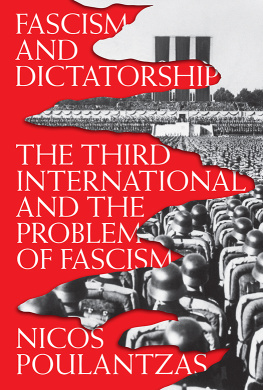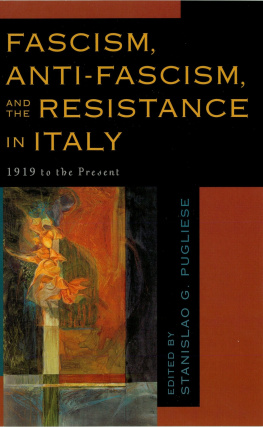ROUTLEDGE LIBRARY EDITIONS: RACISM AND FASCISM
Volume 4
THE COMING OF AUSTRIAN FASCISM
THE COMING OF AUSTRIAN FASCISM
MARTIN KITCHEN
First published in Great Britain in 1980 by Croom Helm Ltd
This edition first published in 2016
by Routledge
2 Park Square, Milton Park, Abingdon, Oxon OX14 4RN
and by Routledge
711 Third Avenue, New York, NY 10017
Routledge is an imprint of the Taylor & Francis Group, an informa business
1980 Martin Kitchen
All rights reserved. No part of this book may be reprinted or reproduced or utilised in any form or by any electronic, mechanical, or other means, now known or hereafter invented, including photocopying and recording, or in any information storage or retrieval system, without permission in writing from the publishers.
Trademark notice: Product or corporate names may be trademarks or registered trademarks, and are used only for identification and explanation without intent to infringe.
British Library Cataloguing in Publication Data
A catalogue record for this book is available from the British Library
ISBN: 978-1-138-93422-1 (Set)
ISBN: 978-1-315-66966-3 (Set) (ebk)
ISBN: 978-1-138-93463-4 (Volume 4) (hbk)
ISBN: 978-1-315-67780-4 (Volume 4) (ebk)
Publishers Note
The publisher has gone to great lengths to ensure the quality of this reprint but points out that some imperfections in the original copies may be apparent.
Disclaimer
The publisher has made every effort to trace copyright holders and would welcome correspondence from those they have been unable to trace.
THE COMING OF AUSTRIAN FASCISM
Martin Kitchen
1980 Martin Kitchen
Croom Helm Ltd, 2-10 St Johns Road, London SW11
British Library Cataloguing in Publication Data
Kitchen, Martin
The coming of Austrian Fascism.
1. Austria Politics and government 1918-1938
1. Title
943.605 DB97
ISBN 0-7099-0133-X
McGill-Queens University Press
1020 Pine Avenue West, Montreal H3A 1A2
ISBN 0-7735-0520-2
Legal deposit 2nd quarter 1980
Bibliothque Nationale du Qubec
Printed and bound in Great Britain
CONTENTS
ACKNOWLEDGEMENTS
I am most grateful to the generous support of the Canada Council, without which this book could not have been written. The staffs of the Allgemeines Verwaltungsarchiv, the Haus- Hof- und Staatsarchiv, the Kriegsarchiv and the Verein fr die Geschichte der Arbeiterbewegung, all of which are in Vienna, were unfailingly helpful. I owe a particular debt of gratitude to Frau Dr Isabella Ackerl of the Wissenschaftliche Kommission des Theodor-Krner-Stiftungsfonds und des Leopold-Kunschak-Preises zur Erforschung der sterreichischen Geschichte der Jahre 1918 bis 1938 for her friendly help and assistance. I am deeply saddened that I am unable to give this book to Ilona Duczynska whose generosity, enthusiasm and encouragement I shall not forget. Her death was a great loss to her many friends throughout the world. Bernice Ferrier and Wilma Wiffin typed the manuscript without losing their good humour.
INTRODUCTION
On 12 February 1934 fighting broke out in Linz between government forces and the Social Democratic Party. Within hours Vienna was up in arms, and the fighting soon spread to other parts of Austria. A few days later the party was destroyed, and Austria seemed to many observers to have joined the ranks of the fascist states. The violence of the fighting, particularly the shelling of the vast workers housing complex, the Karl-Marx-Hof, and the summary execution of a number of the leading figures in the fighting, horrified the civilised world. The struggle of the Austrian workers against the systematic destruction of democratic freedoms, their desperate, frustrated and hopeless fight against overwhelming odds, and their determination that their country should not go the same way as Italy and Germany was an inspiration to many to form an anti-fascist front in which the struggle for socialism became subordinated to the defence of democracy. Yet from the very outset there was a feeling that this effort was too late. The attitude of the Western democracies towards the fascist states and the Stalinist purges in the Soviet Union, and the failures of the popular front governments in Spain and France reinforced this sense of hopelessness. As time went by 12 February ceased to be an inspiration and became a myth, but a myth that could be interpreted in several different ways. Was it an example of determined proletarian class consciousness betrayed by incompetent or even sinister leadership? Did it show the hopelessness of armed struggle against government forces, and thus the need for compromise with extreme right-wing governments? Was it a revolution, or merely a mindless brawl? Was the Social Democratic Party destroyed by its own internal weaknesses, or was it crushed by the government? These questions were not merely the result of various exiles banging their heads against various ideological walls, but they involved fundamental issues of socialism, democracy and fascism. It is largely for this reason that 12 February still excites strong responses, as the discussions at a symposium held in Vienna on the 40th anniversary amply demonstrate.1 Old political resentments certainly linger on, but they now seldom stand in the way of an objective analysis of the failures of the Austrian republic.
The Social Democratic Party of Austria was formed relatively late but it soon earned a deserved reputation for its contribution to socialist thought and for the strength of its organisation and its imaginative educational and artistic activities. Austro-Marxism was soon to become the dominant ideology of the Second International. Like the party on which it was modelled, the German SPD, it suffered from a fatal inability to reconcile demands for revolution with the need for reform, a central difficulty for social democratic parties on which Rosa Luxemburg wrote her most powerful pamphlet, Reform or Revolution? A party with so many outstanding intellectuals was not slow to find solutions to this problem, but in every instance the cure was worse than the disease. The most prevalent attitude was one of revolutionary fatalism, a blind faith in the inexorable laws of historical development that would lead inevitably to socialism. It was thus hardly surprising that Lenin was to hurl some of his most poisonous darts at the Austrian socialists and the philosophical tradition on which it was based.2 This fatalism paralysed the party leadership, the belief in the automatic arrival of socialism combining with a false sense of optimism. Dr Pangloss in Marxist clothes was hardly a figure likely to deal with determined political opponents in a social and economic situation that greatly favoured the right. Austro-Marxism thus served both as a pep pill and a tranquilliser, giving double comfort to a patient who seemed no longer aware of the disease from which he was suffering.
The rhetoric of the party leadership helped to hold the different strands together, although by 1934 internal tensions had reached breaking point. At the same time it convinced many on the right that the party really was a revolutionary menace that had to be destroyed. Other more cynical and realistic politicians deliberately used the radical phraseology of their opponents to justify their attacks on the party. A party that was acting purely in self-defence could thus be presented as preparing for civil war, the Austro-fascist state as the only possible alternative to bolshevism. In fact the party had already been politically defeated by 1934: the Palace of Justice affair of 1927 and the closing of parliament in 1933 were both striking evidence of its inability to combat the rising tide of right-wing extremism. The Communists could demand more determined action, but they were too small a sect to have any influence.














